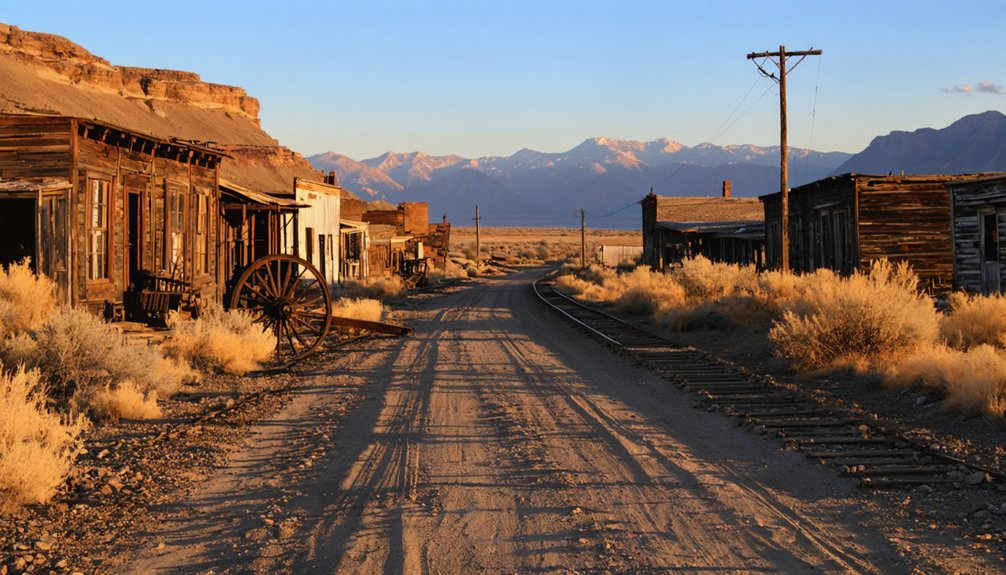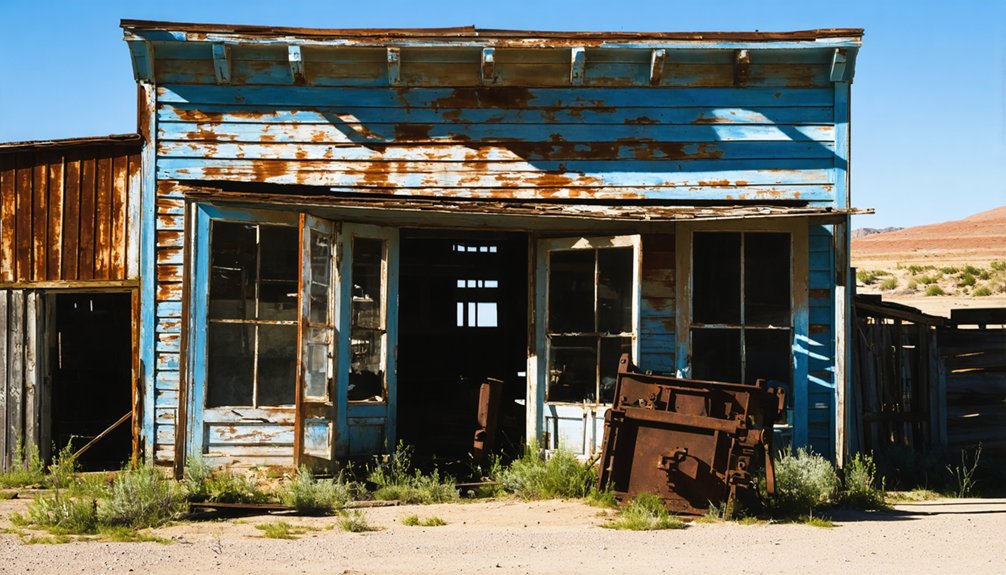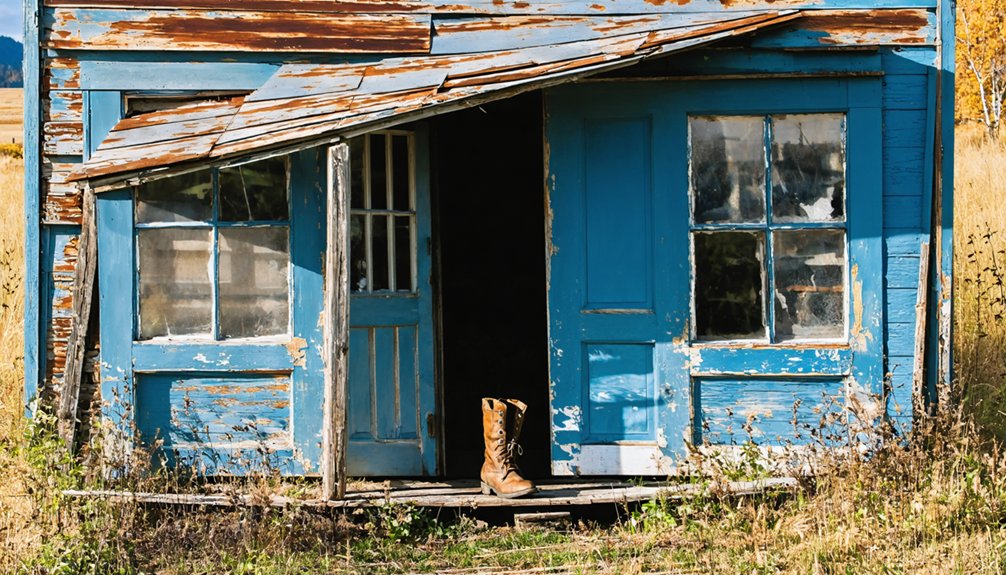You’ll find Callender nestled in Idaho County’s rugged Clearwater Mountains, where it flourished briefly as a gold mining settlement in the 1890s. The town sprang up after prospectors Bert Rigley and Charlie Robbins struck gold at the Big Buffalo Mine, drawing thousands of miners to the area. While the boom lasted just until 1907, you can still explore the remote ghost town’s scattered remains – though you’ll need a four-wheel drive vehicle and detailed maps to navigate the challenging backcountry terrain.
Key Takeaways
- Callender was a mining settlement in Idaho’s Clearwater Mountains established during the gold rush of the 1860s.
- The town flourished around the Big Buffalo Mine until its closure in 1903, leading to economic decline.
- Three waves of mass exodus occurred between 1903-1907, with miners, business owners, and families abandoning the settlement.
- Located in Idaho County’s Salmon River Mountains, the ghost town is surrounded by rugged backcountry and dense coniferous forests.
- Today, only scattered debris remains of Callender, with limited public access due to private property restrictions and challenging terrain.
The Birth of a Mining Settlement
When prospectors discovered quartz gold in Idaho’s Clearwater Mountains‘ Buffalo Hump region, a flurry of mining settlements emerged, including Callender, Orogrande, Hump Town, Concord, and Frog Town.
You’ll find the roots of this mining district stretch back to 1861 when gold seekers first settled Elk City, though fur trappers had explored the area earlier.
The real excitement began when Bert Rigley and Charlie Robbins staked their claim at the Big Buffalo Mine. Their success in claim staking attracted Charles Sweeney, a prominent figure from Coeur d’Alene’s mining scene, who established a mill in 1900.
These bustling settlements served thousands of eager miners throughout the late 1800s into the early 1900s.
As mining techniques evolved and word spread, you’d have seen the rapid development of essential infrastructure – roads, supply lines, and basic services sprouting up to support the growing number of fortune seekers flooding the area.
The mine operated profitably until March 1903, when operations were significantly reduced and continued under the management of Steve Evans.
Life in Buffalo Hump Mining District
Despite the harsh wilderness conditions of Idaho’s Clearwater Mountains, life in the Buffalo Hump Mining District flourished briefly around the turn of the 20th century.
You’d find a bustling community centered around mining techniques that extracted gold, copper, and silver from the phenomenally rich Big Buffalo Mine. The district’s social fabric wove together miners, merchants, and families who called Callender and Orogrande home.
You could grab a drink at one of Orogrande’s saloons, stay at a hotel, or visit the company store in Callender. Community dynamics revolved around the “Code of the West,” while nearly a thousand head of livestock provided sustenance. Charles Sweeney’s mill helped establish the district as a significant mining operation. Two historical PDF documents remain detailing the district’s operations.
Life in the mining towns balanced commerce and camaraderie, with saloons and stores serving as social hubs amid the frontier wilderness.
Though the living conditions were rudimentary, the district’s residents created a vibrant but fleeting society that lasted until the boom’s end in 1907.
Geography and Natural Setting
Nestled deep within Idaho County’s rugged Salmon River Mountains, the ghost town of Callender occupies a remote wilderness setting that’s bordered by untamed backcountry on three sides.
The site’s geological features include steep valleys and ridges typical of Idaho’s mountainous mining regions, with the terrain dominated by native coniferous forests and alpine meadows. Similar to many ghost towns, the abandoned site requires rugged backcountry navigation to reach.
You’ll find Callender’s environmental conservation aided by its isolation and challenging access conditions. The area’s alpine climate brings heavy snowfall from November through June, limiting easy access to summer months.
The surrounding wilderness provides habitat for elk, deer, bears, and mountain lions among stands of lodgepole pine and Douglas fir.
While few structural remains exist today, nature has largely reclaimed this historic mining site, preserving its wild character. Visitors need 4WD vehicles to navigate the rough roads leading to the remote location.
The Gold Rush Years
A momentous gold discovery in the Buffalo Hump Region during the late 19th century sparked Callender’s transformation from wilderness into a bustling mining settlement.
The mining legacy began when Bert Rigley and Charlie Robbins staked the Big Buffalo Mine in 1900, triggering one of America’s last gold rushes.
Under Charles Sweeney’s experienced leadership, the town quickly developed essential infrastructure and services. The area’s rich mineral deposits were part of the Cordilleran orogenic system that shaped much of northern Idaho’s geology.
Here’s what made Callender thrive:
- A sophisticated mill maximized gold extraction from quartz deposits
- Construction of a crucial wagon road connected Callender to Orogrande’s supply hub
- Development included a company store, bank, hospital, and housing for miners
The Big Buffalo Mine operated until March 1903, with the surrounding area producing nearly $69,600 in gold over 29 years – a reflection of Idaho’s enduring mineral wealth.
Daily Life and Social Scene
Life in Callender revolved around vibrant social hubs where miners could escape the grueling work of gold extraction. You’d find the town’s saloons bustling with activity, as men gathered to drink, gamble, and share stories.
The Colgrove Grand Hotel and local stores served as impromptu community centers where you could barter goods, catch up on news, or warm yourself around a woodstove during winter months. Similar to other ghost towns across Idaho, these establishments became the heart of frontier social life.
Social interactions weren’t limited to formal establishments. You might join a game of craps on someone’s cabin porch, attend public events like school examinations, or gather at the general store where the postmaster handled your mail and fishing licenses.
Despite the town’s rough-and-tumble nature, these community gatherings created a sense of belonging in this male-dominated, frontier settlement. The town’s location near Buffalo Hump mountain made it an important stop for thousands of miners seeking their fortune.
Mining Operations and Economic Impact
Three pivotal figures sparked Callender’s meteoric rise in 1899: Bert Rigley and Charlie Robbins, who staked the Big Buffalo Mine after discovering quartz gold in the Buffalo Hump region, and Charles Sweeney, who constructed the first mill in April 1900.
Rigley and Robbins unearthed Buffalo Hump’s golden promise in 1899, while Sweeney’s mill transformed Callender into a mining powerhouse.
The mining techniques and economic fluctuations in Callender reflected the boom-and-bust cycle common to Western gold towns. Similar to other mining operations, they considered transporting ore via aerial tramways to improve efficiency.
You’ll find evidence of this rapid development in:
- J.D. Rockefeller’s incorporation of the Buffalo Hump Mining Company in New York
- The swift establishment of essential services, including a company store, bank, and hospital
- The impressive gold production through Orogrande, totaling $69,598 between 1894-1923
Transportation and Accessibility

While accessing Callender today presents significant challenges, you’ll need to rely primarily on private vehicles to reach this remote ghost town. The absence of public transportation and limited infrastructure means you’ll face various transportation challenges, from rough rural roads to seasonal weather conditions that can complicate your journey.
For accessibility solutions, consider using four-wheel drive vehicles, especially during adverse weather. You’ll want to bring detailed maps and GPS devices, as signage is scarce in this remote area.
If you’re feeling adventurous, you can explore alternative routes via off-road trails, hiking paths, or ATV tracks. Before heading out, check with local historical societies or tourist information centers for up-to-date access information and consider hiring a local guide for the safest, most informative experience.
The Town’s Rapid Decline
You’ll find that Callender’s economic decline followed a familiar pattern seen in many Idaho ghost towns, where diminishing ore quality and limited production from mines like Jumbo and Big Buffalo spelled doom for the community.
Without any economic diversification beyond mining, the town couldn’t sustain itself once mineral yields dropped and mining operations became unprofitable. Families and workers quickly abandoned their homes and businesses, taking only what they could carry as they sought opportunities elsewhere, leaving the town to fade into obscurity.
Mining Operations Cease
Although the Big Buffalo Mine drove Callender’s initial prosperity, its closure on March 19, 1903, marked the beginning of the town’s rapid decline.
Despite Steve Evans’ efforts to maintain limited operations, outdated mining technology and economic shifts made the mine increasingly unprofitable.
You’ll find three main factors that sealed Callender’s mining fate:
- Complex ore processing challenges that couldn’t be solved until flotation technology emerged in the 1920s
- Charles Sweeney’s regional mine consolidations that redirected capital to more productive sites
- The broader decline of the quartz gold boom around 1907
As mining operations ceased, you’d have witnessed the town’s infrastructure crumbling.
The company store, hospital, and bank closed their doors, while the once-bustling supply routes fell silent.
Population Mass Exodus
Three waves of mass exodus swept through Callender between 1903 and 1907, leaving the once-thriving mining town virtually deserted.
You’ll find that the population shift began when the first group of miners departed after initial ore depletion, followed by business owners who couldn’t sustain their operations without a steady customer base.
The final wave saw the community dissolution accelerate as families abandoned their homes, taking whatever possessions they could carry.
Like many Idaho ghost towns of the era, Callender’s decline followed a familiar pattern.
When mining opportunities dried up, you’d have witnessed entire neighborhoods emptying within weeks.
Those who stayed longest were typically the most invested in their properties, but eventually, even they’d to accept the harsh reality and move on to more promising locations.
Present-Day Remnants

Despite once being a settled community in central Idaho, Callender’s present-day physical remnants are particularly sparse.
You’ll find few remnant structures still standing, though scattered debris offers subtle hints of past life throughout the area. The site has transformed into mainly rural land, with most of it now under private ownership.
If you’re planning to explore this historic location, you should be aware of:
- Limited public access due to private property restrictions
- Remote location making navigation challenging
- Natural erosion that continues to diminish the remaining physical evidence
While not as well-preserved as other Idaho ghost towns like Bayhorse or Silver City, Callender’s site still holds historical significance as a reflection of the region’s agricultural heritage, though you’ll need local knowledge and permission to properly investigate the area.
Exploring the Ghost Town Today
When planning a visit to Callender ghost town, you’ll need to prepare for a challenging journey through Idaho’s rugged wilderness.
You’ll find the last few miles particularly demanding, requiring a reliable 4WD vehicle to navigate the rough terrain that leads to this remote mining site.
Your ghost town adventures can extend beyond Callender’s boundaries, with nearby Concord and Hump Town offering additional historical perspectives.
During your wilderness exploration from July through September, you’ll encounter stunning mountain vistas and diverse wildlife in the surrounding wilderness areas.
While Callender doesn’t boast the extensive remains found in other Idaho ghost towns like Silver City or Bayhorse, its isolated setting provides an authentic glimpse into the state’s mining heritage, perfect for photography and hiking enthusiasts.
Frequently Asked Questions
Were Any Notable Crimes or Shootouts Recorded in Callender’s History?
You won’t find documented crime reports or shootout incidents from Callender’s history, though the town’s lawless nature and remote location likely led to unrecorded conflicts among miners and residents.
Did Native American Tribes Have Any Interaction With the Mining Settlement?
While historical treaties likely influenced the area, you’ll find limited documented evidence of direct Native American interactions with Callender’s miners, though cultural exchange and mining impact certainly affected regional tribes.
What Was the Average Gold Yield per Ton From Callender’s Mines?
You can’t determine Callender’s exact gold extraction yields, but based on similar Idaho mining techniques of that era, mines likely produced between 3-6 grams per tonne (0.1-0.2 ounces per ton).
Were There Any Schools or Churches Established During the Town’s Existence?
You won’t find any documented school history or church significance in Callender. The town’s mining focus and transient population meant religious and educational facilities weren’t established during its brief existence.
Did Any Famous Pioneers, Outlaws, or Historical Figures Visit Callender?
You won’t find any documented famous visitors or pioneer stories about notable figures in Callender’s history. The remote mining town’s records don’t mention any well-known outlaws or historical personalities passing through.
References
- https://idaho-forged.com/idahos-ghost-towns-eerie-yet-approachable/
- https://dustywindshield.wordpress.com/2016/09/10/orogrande-mining/
- https://yellowpinetimes.wordpress.com/2023/10/08/idaho-history-oct-8-2023/
- https://liteonline.com/eerie-video-shows-whats-left-of-one-of-idahos-most-unique-ghost-towns/
- https://www.ghosttowns.com/states/id/callender.html
- https://dustywindshield.wordpress.com/2019/08/19/buffalo-mining-region-orogrande-the-colgove-hotel/
- https://www.youtube.com/watch?v=uqsVJKcyCYw
- https://yellowpinetimes.wordpress.com/2016/12/11/idaho-history-dec-11/
- https://npshistory.com/publications/usfs/region/1/nez-perce/history/sec1.htm
- https://www.idahogeology.org/pub/Pamphlets/P-131.pdf



